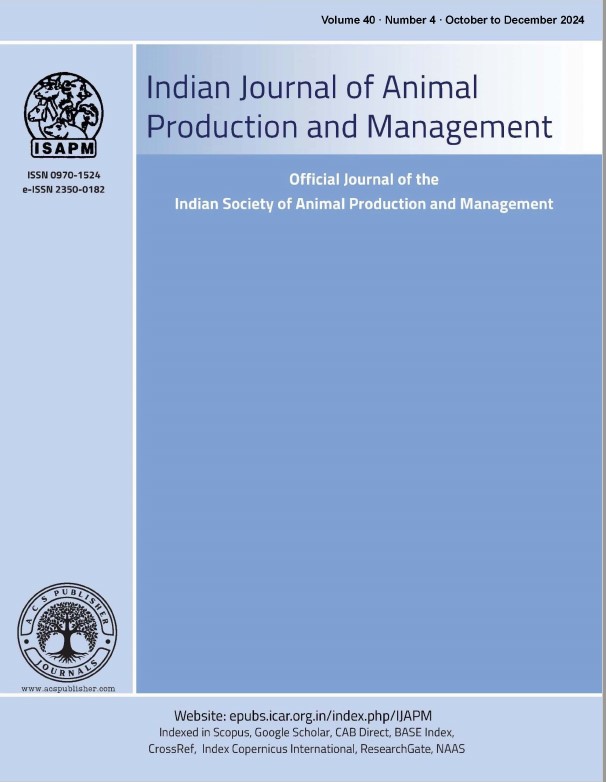Economic Evaluation of Species Composition Effects on Feed Costs in Indi an Major Carp Polyculture: A Case Study from Tripura, India
DOI:
https://doi.org/10.48165/ijapm.2025.41.1.5Keywords:
Composite fish culture, Indian major carps, Feed Cost, Production Income, NE IndiaAbstract
In this study, the ratio of feed cost to production income was determined for carp polyculture systems in Tripura, India. Data was collected from experimental ponds over a 10-month culture period from May to February. Three different species compositions of Indian major carps were evaluated: Treatment 1 (Catla 40%, Rohu 30%, Mrigal 30%), Treatment 2 (Catla 30%, Rohu 40%, Mrigal 30%), and Treatment 3 (Catla 30%, Rohu 30%, Mrigal 40%). All ponds were stocked at a density of 7500 fingerlings per hectare in 200 m² experimental ponds with water depths of 1-1.5 m. Feed consumption, growth parameters, and economic indicators were monitored throughout the production cycle. Other operating costs during the production period (pond preparation, fingerlings, labor, equipment, depreciation, marketing, etc.) were excluded from the analysis. In carp polyculture, feed represents the highest share of total production costs during the growing period. According to the study results, the feed cost/production income ratio of Treatment 2 was the most favorable at 0.28, followed by Treatment 1 at 0.29, and Treatment 3 at 0.31. Production levels ranged from 4000-4090 kg/ha across treatments. Treatment 2 showed better economic performance due to the higher proportion of Rohu, which demonstrated superior feed conversion rates under the study conditions. The findings suggest that optimizing species composition in carp polyculture systems can improve economic returns by enhancing feed utilization efficiency.
References
APHA. (2017). Standard methods for the examination of water and wastewater (23rd ed.). Washington DC: American Public Health Association.
Ayyappan, S., Moza, U., Gopalakrishnan, A., Meenakumari, B., Jena, J. K., & Pandey, A. K. (2019). Handbook of fisheries and aquaculture. Directorate of Knowledge Management in Agriculture, Indian Council of Agricultural Research, New Delhi.
Baki, B., & Yücel, Ş. (2017). Feed cost/production income analysis of seabass (Dicentrarchus labrax) aquaculture. International Journal of Ecosystems and Ecology Sciences, 7(4), 859–864.
Biswas, A., & Mandal, S. (2021). Comparative growth performance of rohu (Labeo rohita) fed with low cost feeds using locally available animal proteins in Purulia district of West Bengal. Journal of Crop and Weed, 17(1), 252–256.
Bjørndal, T., Dey, M., & Tusvik, A. (2024). Economic analysis of the contributions of aquaculture to future food security. Aquaculture, 578, 740071.
Das, P. C., & Ferosekhan, S. (2022). Recent advances in carp culture in India. In Souvenir of 1st Indian Fisheries Outlook (pp. 73–83). ICAR-CIFRI, Kolkata.
De, H. K., Shasani, S., Das, M. K., & Saha, G. S. (2020). An economic appraisal of composite carp culture in West Bengal. Journal of Extension Education, 32(2), 6492–6499.
Debnath, B., Biradar, R. S., Krishnan, M., Pandey, S. K., Debnath, C., Srivastava, S. K., & Das, S. C. S. (2015). Economic evaluation on fish production and demand in Tripura – strategic options. Indian Journal of Animal Sciences, 85(10), 1139–1145.
Debnath, C. (2024). Composite fish culture enhances fish productivity in rural Tripura, Northeast India. Indian Farming, 74(6), 24–27.
Debnath, C., Dube, K., Saharan, N., Tiwari, V. K., Datta, M., & Sahoo, L. (2020). Assessment of growth and production potential of Indian butter catfish Ompok bimaculatus as a substitute for mrigal Cirrhinus mrigala in polyculture of Indian major carps. Indian Journal of Fisheries, 67(4), 48–55.
Debnath, C., Sahoo, L., Debnath, B., Das, S. K., & Ngachan, S. V. (2018). Economics of fish farming in Tripura. Indian Journal of Hill Farming, Special Issue, 87–91.
FAO. (2024). The state of world fisheries and aquaculture 2024 – Blue transformation in action. Rome: Food and Agriculture Organization of the United Nations.
Food and Agriculture Organization of the United Nations. (2009). Impact of rising feed ingredient prices on aquafeeds and aquaculture production. Rome: FAO.
Jayasankar, P. (2018). Present status of freshwater aquaculture in India – a review. Indian Journal of Fisheries, 65(4), 157–165.
Jena, J. K., Ayyappan, S., & Aravindakshan, P. K. (2002). Comparative evaluation of production performance in varied cropping patterns of carp polyculture systems. Aquaculture, 207(1–2), 49–64.
Jena, J., & Das, P. C. (2011). Grow-out performance of Kuria labeo, Labeo gonius (Hamilton), with major carps in carp polyculture system. Aquaculture Research, 42(9), 1332–1338.
Jena, J., Das, P. C., Kar, S., & Singh, T. K. (2008). Olive barb, Puntius sarana (Hamilton) is a potential candidate species for introduction into the grow-out carp polyculture system. Aquaculture, 280(1–4), 154–157.
Losordo, T. M., & Westerman, P. W. (2007). An analysis of biological, economic, and engineering factors affecting the cost of fish production in recirculating aquaculture systems. Journal of the World Aquaculture Society, 25(2), 193–203.
Naylor, R. L., Hardy, R. W., Buschmann, A. H., Bush, S. R., Cao, L., Klinger, D. H., Little, D. C., Lubchenco, J., Shumway, S. E., & Troell, M. (2021). A 20-year retrospective review of global aquaculture. Nature, 591(7851), 551–563.
Pillay, T. V. R., & Kutty, M. N. (2005). Aquaculture: Principles and practices (2nd ed.). Blackwell Publishing.
Sah, U., Mukhiya, Y., & Pradhan, N. (2018). Effect of different types of feed on growth pattern of farmed rohu and genetically improved rohu (Labeo rohita). International Journal of Fisheries and Aquatic Studies, 6(6), 364–367.
Singh, P. K. (2019). Comparative study of composite fish culture and local practices of fish culture in Surguja district of Chhattisgarh. Journal of Krishi Vigyan, 7(2), 36–39.
Verdegem, M., Buschmann, A. H., Latt, U. W., Dalsgaard, A. J. T., & Lovatelli, A. (2023). The contribution of aquaculture systems to global aquaculture production. Journal of the World Aquaculture Society, 54(2), 206–250.
Wahab, M. A., Kadir, A., Milstein, A., & Kunda, M. (2011). Manipulation of species combination for enhancing fish production in polyculture systems involving major carps and small indigenous fish species. Aquaculture, 321(3–4), 289–297.

